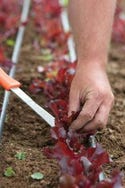Organic business: what it really takesOrganic business: what it really takes
Delicious Living Editor-in-Chief Radha Marcum interviews farmers and industry experts in this behind-the-scenes look at the costs and challenges it takes to grow, produce, market, and get organic foods onto retailers' shelve and into consumers' shopping carts.
August 26, 2011

Early April. At Isabelle Farm, an organic market farm in Lafayette, Colorado, planting has commenced. Tender seedlings cultivated in greenhouses are ready to put down elaborate roots systems in the earth. The farm’s community-supported agriculture (CSA) and business manager, Tiffany Cooper, and several field hands transplant plots of chard, kale, and collards while I hop on the tractor with farmer-owner Jason Condon.
“Normally, the plowing we’re doing right now, I would have done last fall,” says 33-year-old Condon, a fourth-generation local farmer. “But it was really dry. As it turns out, we should have plowed then, because we didn’t get any snow.” The grassy, dandelion-flecked field he’s turning over will be planted with about 6,000 pounds of seed potato by next week. “We can’t wait any longer,” he says.

Six-year-old Isabelle Farm is a good example of where organic starts: not with a certain number of acres, but with a commitment—as rich and complex as the farm’s soil—to the principles that growing food should be a partnership with natural processes and that food should nourish and cause no harm.
In my role at Delicious Living, I talk to a lot of passionate organic entrepreneurs, certifiers, policy advocates, and researchers across the United States. And what impresses me most is this: Organic production is difficult. Yes, organic has grown into a $29 billion industry according to a recent Organic Trade Association report, but organic businesses still face significant, unique challenges that only the most persistent, smart, and lucky overcome. The next time you wonder why organic lettuce costs a dollar more than conventional, keep the following efforts in mind.
Knowledge and infrastructure
“A lot of organic farmers are starting from scratch. They’re relying on books and so forth, and that’s challenging,” says Condon, who feels lucky to have a farming background and access to organic mentors in Colorado.
Whether transitioning from conventional methods or building an organic operation from the ground up, new organic farms need daily land-management skills to succeed, says Ariane Lotti, policy director of the Organic Farming Research Foundation (OFRF). “Right now [the United States has] an infrastructure that’s set up to support the needs of conventional farmers,” says Lotti. “Organic production is a totally different ball game. It’s more management intensive; usually farmers are growing a more diverse set of crops.” Because farmers aren’t using pesticides, they need to work harder with more creative solutions to manage pest infestations.
Up-front costs
“It’s tough when you’re only making good money three months of the year and you’re vulnerable to a lot of uncontrollable factors,” muses Condon. According to the USDA, the average yearly production cost for conventional U.S. farms is just over $109,000; for organic farms, it’s more than $170,000.
Although farmers across the board are finding it more difficult to access loans, organic farmers are at greater financial risk when crops fail. Organic insurance policies are difficult to obtain, and the available plans tack on a 5 percent surcharge “because of the mistaken assumption that the practices are riskier and they are at a greater risk of losing the crop,” says Lotti. If the crop is lost, insurance companies reimburse organic farmers at the lower, conventional price.
Labor costs are significantly higher, too, “because you can’t just go spray a field and be done with it,” explains OFRF Executive Director Maureen Wilmot.
Certification
Knowing what is and isn’t allowed according to the USDA National Organic Program’s standards is key to getting certified. It’s a rigorous ongoing endeavor that requires vigilant attention to every detail, says Condon, which is one of the reasons Isabelle Farm employs Cooper full-time, year-round.
Organic farmers must also ensure that pollution or genetically modified organisms (GMOs) do not contaminate their own crops. “That burden falls solely on the organic farmer,” says Lotti. “The conventional farmer can plant and spray, but the organic farmer is responsible for creating the buffers and making sure the supply chain and fields are clean.”
Sourcing
Further up the chain, manufacturers face significant hurdles in sourcing organic ingredients. “It’s amazing the amount of work [it takes] to bring a product to market,” says Jake Lewin, chief certification officer at CCOF, one of the nation’s oldest and largest  certifiers of organic farms and products. Organic companies, both large and small, “might spend years trying to develop the supply and find growers who will contract to produce for them,” he says.
certifiers of organic farms and products. Organic companies, both large and small, “might spend years trying to develop the supply and find growers who will contract to produce for them,” he says.
Kopali Organics, for example, works directly with farmers and cooperatives all over the world, many of which were not previously in global trade. “Working with small producers takes more time and effort,” says Zak Zaidman, Kopali’s cofounder and CEO.
Marketing and shelf space
Competing with cheaper, nonorganic products can make it difficult to get stores to sign on, says Zaidman. Why? Organic, fair-trade products like Kopali’s chocolate fruit treats are naturally more expensive than those made with ingredients “grown unsustainably, that contain cocoa from farms that might have child labor or child slavery,” says Zaidman. So distributors and retailers likely won’t make as large a profit margin on products such as Kopali’s.
Consumers are key. “Large companies might have more money to spend getting their products onto shelves,” Zaidman says. ”We have to build sales on personal relationships, on people experiencing and tasting the product, on connecting with the company’s mission.”
Challenge taken
“Given these challenges, the commitment of organic farmers and ranchers to producing organically really is amazing,” says Lotti. Behind that commitment? A passionate belief in  the greater good. “I’ve learned so much from farmers and cooperatives that could be role models for the rest of the world, who have so much to say to the question, ‘Can we feed the planet without destroying it—without poisoning ourselves?’” says Zaidman, who started Kopali Organics after observing the stark contrast between indigenous and modern, chemical-intensive growing methods in Costa Rica.
the greater good. “I’ve learned so much from farmers and cooperatives that could be role models for the rest of the world, who have so much to say to the question, ‘Can we feed the planet without destroying it—without poisoning ourselves?’” says Zaidman, who started Kopali Organics after observing the stark contrast between indigenous and modern, chemical-intensive growing methods in Costa Rica.
“What you buy for food matters in the big picture of the world,” says Condon, as he observes his son and daughter, ages 2 and 4, who have come out to watch the plowing. “Every piece of food we buy has an environmental effect, a health effect, and a social and economic effect.” You don’t need to make an extreme choice every time, he says, but “commit to buying one thing organic—fruit or vegetables or grass-fed beef—and realize the consequences of your other choices.”
You May Also Like



